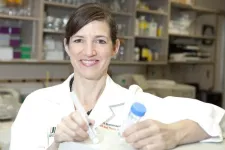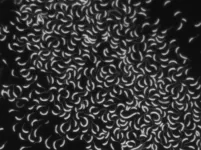(Press-News.org) MIAMI, FLORIDA (EMBARGOED UNTIL AUG. 15, 2024 @ 11 A.M. EDT) – For years, mouthwash has been marketed as an essential hygiene item to prevent bad breath, even though it offers minimal if any health benefits.
But what if a mouthwash-based test to detect biomarkers can help physicians predict disease recurrence in head and neck cancer patients?
That futuristic scenario seems closer to reality after a new study by researchers at Sylvester Comprehensive Cancer Center at the University of Miami Miller School of Medicine, UC San Diego Health and collaborating cancer centers.
Their findings, published Aug. 15 in the peer-reviewed journal JAMA Otolaryngology – Head & Neck Surgery, could improve how physicians predict and detect recurrence with these cancers.
“Our study suggests biomarker detection in saliva collected from an oral rinse after initial treatment offers potential to readily assess recurrence risk,” said Elizabeth Franzmann, MD, a head and neck surgeon at Sylvester, and co-corresponding author of the study. “Elevated levels of either of two biomarkers were associated with disease return.”
Men More Susceptible
Head and neck cancers account for nearly 4% of all cancers in the U.S. and are more commonly diagnosed in people over age 50, according to the National Cancer Institute. Men are more than twice as likely to be diagnosed with the disease.
Primary treatment options include surgery and radiation, which can affect speech, swallowing and appearance, severely affecting a patient’s quality of life. These effects can be even worse after recurrence.
Moreover, recurrence is not always easy to catch. “It can be very difficult to determine if what you’re observing is just post-treatment changes or a cancer recurrence,” explained Joseph Califano III, MD, director of UC San Diego’s Hanna and Mark Gleiberman Head and Neck Cancer Center and the study’s co-corresponding author. “Good biomarkers could help remove some of the guesswork.”
Franzmann, whose research lab is focused on finding an inexpensive, noninvasive screening test for these cancers, emphasized the importance of early recurrence detection. “These patients suffer terribly,” she said. “The more we can minimize those effects by catching recurrence early, the better we can mitigate patient morbidity and mortality.”
Assessing Recurrence Risk
Previously, Franzmann and her team had studied how biomarkers in oral rinses can assess a person’s risk for developing oral or oropharyngeal tumors, the most common types of head and neck cancers. They found a link with two key biomarkers – CD44, a tumor-initiating molecule, and total protein levels.
In this new study, the researchers studied whether those two biomarkers could predict recurrence in already-diagnosed patients. Their clinical trial evaluated the effects of CD44 and total protein levels in 160-plus patients across multiple cancer centers. Patients were provided oral-rinse samples for use up to 18 months after their initial treatment.
To measure biomarker presence, the researchers used laboratory tests and experimental lateral-flow tests, technology similar to stick-based pregnancy and COVID-19 tests.
“Our laboratory assays showed an association between biomarker levels and later recurrence,” Franzmann said. “Compared to patients with normal protein levels three months after treatment, patients with about twice as much total protein had an estimated 65% greater risk of recurrence.”
She added that patients with CD44 levels that were triple the normal level had an estimated 62% percent greater recurrence risk.
Focus on Rapid Tests
The study also generated early data on a rapid, point-of-care test to measure these biomarkers, with the findings expected to help hasten its development.
“It would be really useful if we had a test that was inexpensive and could be performed and resulted while the patient was in the office,” said Franzmann. “That’s the area we are focusing on.”
She and collaborators noted that although additional research is needed, biomarkers show great promise for refining risk prediction in patients with head and neck cancers. Better risk prediction, in turn, has the potential to save lives by reducing the need for harsh, invasive treatments. Thanks is extended to Vigilant Biosciences for their contribution to this work.
# # #
about Sylvester research on the InventUM Blog and follow @SylvesterCancer on X for the latest news on its research and care. (NOTE: InventUM link will be live when the embargo lifts.)
# # #
Authors: A complete listing of authors is available in the paper.
Article Title: Oral Rinse CD44 and Total Protein Levels Are Associated with Oral & Oropharyngeal Cancer Recurrence
DOI: 10.1001/jamaoto.2924.2490
Funding: Support provided by the U.S. Department of Health and Human Services (HHS), the National Institute of Health (NIH) and the National Cancer Institute (NCI).
Disclosures: Franzmann is an inventor of intellectual property used in the study. She and the University of Miami may receive royalties for future commercialization of the intellectual property. Additionally, the University of Miami and Franzmann hold equity in Vigilant Biosciences, licensee of the intellectual property. Franzmann is also the scientific founder, advisor and consultant for Vigilant Biosciences.
END
The Department of Health Behavior & Health Education at the University of Michigan School of Public Health will become the Department of Health Behavior & Health Equity, effective August 15, 2024. The new name reflects the department’s increasing focus on issues of health equity in research, teaching and service.
“Health equity is at the core of our mission and actions in public health,” said F. DuBois Bowman, dean of Michigan Public Health. “I am grateful to the many members of the Health Behavior & Health Equity community ...
WASHINGTON — Researchers have developed a new two-photon fluorescence microscope that captures high-speed images of neural activity at cellular resolution. By imaging much faster and with less harm to brain tissue than traditional two-photon microscopy, the new approach could provide a clearer view of how neurons communicate in real time, leading to new insights into brain function and neurological diseases.
“Our new microscope is ideally suited for studying the dynamics of neural networks in real time, which is crucial for understanding fundamental brain functions such as learning, memory and decision-making,” said research team leader ...
(WASHINGTON, August 15, 2024) – Over half of people with iron deficiency were found to still have low iron levels three years after diagnosis, and among patients whose condition was effectively treated within that timeframe, they faced longer-than-expected delays, pointing to substantial gaps in appropriate recognition and efficient treatment of the condition, according to a study published today in Blood Advances.
Iron deficiency, or when the body’s iron stores are too low, is common, and may affect up to 40% of adolescents and young women. Iron is important in maintaining many body functions, including the production of ...
The National Institutes of Health (NIH) has launched a program that will support Native American communities to lead public health research to address overdose, substance use, and pain, including related factors such as mental health and wellness. Despite the inherent strengths in Tribal communities, and driven in part by social determinants of health, Native American communities face unique health disparities related to the opioid crisis. For instance, in recent years, overdose death rates have been highest among American Indian and Alaska Native people. Research prioritized by Native communities is essential ...
Weill Cornell Medicine has received a five-year, $12.4 million grant from the National Cancer Institute, part of the National Institutes of Health, for an extensive program of basic and translational research on the biology of diffuse large B-cell lymphoma (DLBCL), the most common form of lymphoma.
The investigator-initiated Program Project grant, led by Dr. Leandro Cerchietti, the Richard A. Stratton Associate Professor in Hematology and Oncology at Weill Cornell Medicine, and Dr. Christopher Flowers, professor and chair of the Department of Lymphoma and Myeloma at The University ...
The National Institute of General Medical Sciences, a branch of the National Institutes of Health (NIH), has awarded Yubing Sun, associate professor of mechanical and industrial engineering at the University of Massachusetts Amherst, a $1.9 million Maximizing Investigators’ Research Award to support the exploration of the fundamental principles behind the process that close gaps caused by injury or growth between cells. This research has the potential to push forward advances in our understanding of wound healing, cellular regeneration therapies and embryonic development.
The gaps ...
**EMBARGOED UNTIL THURSDAY, AUG. 15, AT 9 A.M. ET**
In what they labeled a “surprising” finding, Johns Hopkins Medicine researchers studying bacteria from freshwater lakes and soil say they have determined a protein’s essential role in maintaining the germ’s shape. Because the integrity of a bacterial cell’s “envelope” or enclosure is key to its survival, the finding could advance the search for new and better antibiotics.
The research, described August 15 in the journal mBio, suggests that loss of a protein ...
A genetic analysis of Lyme disease bacteria may pave the way for improved diagnosis, treatment and prevention of the tick-borne ailment.
By mapping the complete genetic makeup of 47 strains of Lyme disease-causing bacteria from around the world, the international team has created a powerful resource for identifying the specific bacterial strains that infect patients. Researchers said this could enable more accurate diagnostic tests and treatments tailored to the exact type or types of bacteria causing each patient’s illness.
"This comprehensive, high-quality sequencing investigation of Lyme disease and related bacteria provides the foundation to propel the field forward,” ...
A team led by CUNY Graduate Center biologists has produced a genetic analysis of Lyme disease bacteria that may pave the way for improved diagnosis, treatment, and prevention of the tick-borne ailment.
Weigang Qiu, a professor of Biology at the CUNY Graduate Center and Hunter College, and an international team including lead author Saymon Akther, a former CUNY Graduate Center Biology Ph.D. student, mapped the complete genetic makeup of 47 strains of Lyme disease-related bacteria from around the world, creating a powerful tool for identifying the bacterial strains that ...
CLEVELAND—More than 3,400 Sudden Unexpected Infant Deaths are reported annually in the United States, making it the country’s biggest cause of death of infants from 1 month to 1 year old, according to the Centers for Disease Control and Prevention (CDC).
Most of these deaths are classified as Sudden Infant Death Syndrome (SIDS), a disorder with numerous, unexplained causes that have plagued researchers for decades.
Now, with a new five-year, $2.8 million grant from the National Institutes of Health, researchers from Case Western Reserve University and University Hospitals Rainbow Babies ...



